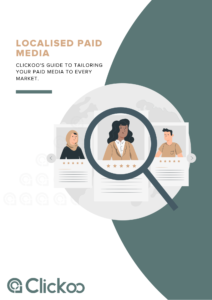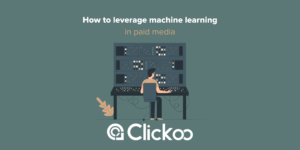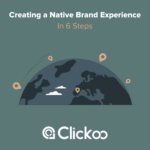Leveraging Machine Learning In Paid Media
Want to inform your paid media advertising strategy? Make better decisions to boost performance? You need to get the most out of machine learning (ML).
We’ve already given an introduction to ML and its various applications, including how it’s used in paid media advertising. Here, though, we’re going to go into much further detail – and explore how you can get the most out of it.
Join us as we explain exactly how to leverage this technology in advertising.
How does machine learning work in paid media?
Firstly, let’s understand what machine learning does well when it comes to paid media campaigns. You can perform super-efficient multivariate testing, for one. Plus, the machine has access to so many more data points – humans can obviously collate their own information, but this can only go so far.
The likes of Amazon, Google Ads and Facebook use hundreds of 1st party signals that humans don’t have access to. They also have third-party data access that they have effectively categorised to help boost the performance of your campaigns, even if you have no first-party data.
Whilst we can’t praise ML enough, it’s not without its shortcomings. Ultimately, it is a machine – and therefore can only manage campaigns as well as we empower them to. This means that information like broader context might not be recognised by ML. In this way, machine learning has to work together with the human…
How can you use machine learning better?
To truly capitalise on the powers of ML in paid media, you have your own part to play. You can help this technology in six key ways:
Data quality
The power of machine learning based optimisations is quite astounding, with complex data-sets analysed and recommended actions taken in a fraction of the time it would take a human to undertake the same task. However, the machine is only as powerful as the data you give it. Ensuring that your website tracking tags are implemented correctly, and that the conversion goals set in your advertising accounts accurately represent the goals you’re looking to achieve is critical to focusing the power of the machine in the right direction. For example, if your Google ads conversions are set to record both lower intent content downloads and higher intent enquiry forms, unless you take action to avoid it the machine will treat these as equally important. This would usually result in the machine investing more heavily in generating cheaper, lower intent content downloads rather than the higher value enquiry leads you may be looking to achieve.
Attribution
Continuing on from the importance of feeding the machine with quality data, allowing it to access data from the whole user journey, rather than just the last advert they clicked on is important to growing your returns with machine learning. If the conversion data provided to the machine favours the final interaction audiences make, your conversion volumes will be restricted as the campaigns aren’t allowed to invest as heavily in upper funnel terms, despite the vital part they play in starting the customers journey to conversion.
Data volume
Ensuring that the information available to the machine allows for optimisations based on statistically significant data sets is vital. Often platforms will have built in fail-safes, that require a minimum volume of conversions to have occurred before the machine will begin to make optimisations. Some platforms will term the period required to build up a data set with statistical significance the ‘learning period’.
One example of this might be, keyword 1 with 1000 clicks and 100 conversions represents a 10% conversion rate. Keyword 2, which has only generated 10 clicks, but has resulted in 1 conversion would also represent a 10% conversion rate.
Both keywords might be seen as performing equally well when assessed purely on the basis of conversion rate, but due to the much higher volume of signal data received by Keyword 1 during the 1000 clicks, audience behaviour trends become much more clearly defined and easier to optimise towards.
Account structures
Traditionally, campaigns are set up granularly. By splitting them into as many silos as possible, you can see exactly what works and what doesn’t, and have the most control over your investment.
However, ML warrants a slightly different approach. Get too granular, and you limit the data the machine has access to. This will ultimately hamstring it’s capabilities to achieve your goals. It’s all about feeding your machine with data so it can learn quickly; structure your campaigns so they consider the strengths and weaknesses of the machine, and you’ll get better results.
Targeting
It’s important to remember that as advertisers, we only really see the tip of the iceberg when it comes to how our targeting decisions are applied by the advertising platforms. There are 1000’s of signals hidden beneath each targeting option, signals which the machine has access to and considers during its decision making process.
Building a robust understanding of your audience is critical, especially if your audience doesn’t sit under one of the pre-defined categories provided by the platforms. You’ll have to think outside of the box in order to really connect with the right audience.
Creative
Thanks to the machine doing a lot of the heavy lifting when it comes to data management, human account managers have more time to create and test engaging ad messaging and imagery, carrying out A/B and multivariate testing at a greater scale and with machine assisted precision.
Remember to only test different versions of creative conservatively when you have a restricted budget. Otherwise, you’ll end up with pretty lengthy learning periods for your campaigns. Remember each ad variation needs to be tested against each different targeting criteria enough times at a live auction to gain a statistically significant insight.
Partnering with Clickoo for your campaigns
By leveraging the latest in automation and machine learning technology, you really can achieve the very best campaign performance. But getting the most out of this sort of technology can take years of practice. Thankfully, you don’t have to spend your own time on this. You can turn to a paid media agency, like Clickoo.
We’re well versed in maximising the powers of machine learning in paid media, having driven success for our clients time and time again. And this wasn’t in just one country either. With us, you’ll be able to reach your desired performance and ROI, regardless of the territories you’re advertising in. Localisation is our heartbeat, so you can be certain that your growth goals won’t be just met – but exceeded.
Get in touch with Clickoo today, and supercharge the use of machine learning in your paid media advertising campaigns.
Want to grow your campaigns beyond machine learning?

Fill the form below to receive Clickoo’s guide to connecting with audiences via Localised Paid Media.
});



